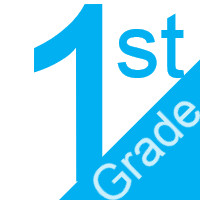1st Grade English
Completion requirements
 Prioritized Standards
Prioritized Standards
 Standards Glossaries
Standards Glossaries
| K Grade English | 1st Grade English | 2nd Grade English |
 Standards Glossaries
Standards Glossaries
| 3rd Grade English | 4th Grade English | 5th Grade English |
 Standards Glossaries
Standards Glossaries
| 6th Grade English | 7th Grade English | 8th Grade English |
 Standards Glossaries
Standards Glossaries
| 9th Grade English | 10th Grade English | 11th Grade English | 12th Grade English |
 Standards Glossaries
Standards Glossaries
| HS Journalism | HS Speech |
| (RF) Reading Foundations |
ELA-01.RF.01ELA-01.RF.01 Demonstrate understanding of the organization and basic features of print.a. Recognize the distinguishing features of a sentence. Student Learning Targets:Knowledge Targets
Reasoning Targets
Skills (Performance) Targets
Proficiency ScaleThe Student Will ...1 Beginning... with help, demonstrates a partial understanding of some of the simpler details and processes (Score 2.0 content) and some of the more complex ideas and processes (Score 3.0 content).
2 Developing... demonstrates no major errors or omissions regarding the simpler details and processes but exhibits major errors or omissions regarding the more complex ideas and processes (Score 3.0 content).
3 Proficient“The Standard.”... demonstrates no major errors or omissions regarding any of the information and processes that were end of instruction expectations.
4 Advanced... demonstrates in-depth inferences and applications regarding more complex material that go beyond end of instruction expectations.
ResourcesVocabulary
Websites
| |
ELA-01.RF.01a
Student Learning Targets:Knowledge Targets
Proficiency (Rubric) Scale
ResourcesWebsitesVocabulary
| ||||||||||||||||||||||||||||||||||||||||
ELA-01.RF.02
ELA-01.RF.02 Demonstrate understanding of spoken words, syllables, and sounds (phonemes).Sub-Standards:
a. Distinguish long from short vowel sounds in spoken single-syllable words.
b. Orally produce single-syllable words, by blending sounds (phonemes), including consonant blends.
c. Isolate and pronounce initial, medial vowel, and final sounds (phonemes) in spoken single-syllable words.
d. Segment spoken single-syllable words into their complete sequence of individual sounds (phonemes) Student Learning Targets:Knowledge Targets
Reasoning Targets
Skills (Performance) Targets
Proficiency ScaleThe student can ...1 Beginning... with help, demonstrates a partial understanding of some of the simpler details and processes (Score 2.0 content) and some of the more complex ideas and processes (Score 3.0 content).Start 2 Developing... demonstrates no major errors or omissions regarding the simpler details and processes but exhibits major errors or omissions regarding the more complex ideas and processes (Score 3.0 content).Simple 3 Proficient“The Standard.”... demonstrates no major errors or omissions regarding any of the information and processes that were end of instruction expectations. Target 4 Advanced... demonstrates in-depth inferences and applications regarding more complex material that go beyond end of instruction expectations.Complex ResourcesVocabulary
Websites
| |||
ELA-01.RF.03
ELA-01.RF.03 Know and apply grade-level phonics and word analysis skills in decoding words.Sub-Standards:
a. Know the spelling-sound correspondences for common consonant digraphs.
b. Decode regularly spelled one-syllable words. c. Demonstrate use of beginning and ending blends d. Know final -e and common vowel team conventions for representing long vowel sounds.
e. Use knowledge that every syllable must have a vowel sound to determine the number of syllables in a printed word.
f. Decode two-syllable words following basic patterns by breaking the words into syllables. g. Read words with inflectional endings. h. Recognize and read grade-appropriate irregularly spelled words. | |
ELA-01.RF.04ELA-01.RF.04 Read with sufficient accuracy and fluency to support comprehension.Sub-Standards:
a. Read grade level text with purpose and understanding.
b. Read grade level text orally with accuracy, appropriate rate, and expression on successive readings.
c. Use context to confirm or self-correct word recognition and understanding, rereading as necessary.
Student Learning Targets:Knowledge Targets
Reasoning Targets
Skills (Performance) Targets
Proficiency ScaleThe student can ...1 Beginning... with help, demonstrates a partial understanding of some of the simpler details and processes (Score 2.0 content) and some of the more complex ideas and processes (Score 3.0 content).Start 2 Developing... demonstrates no major errors or omissions regarding the simpler details and processes but exhibits major errors or omissions regarding the more complex ideas and processes (Score 3.0 content).Simple 3 Proficient“The Standard.”... demonstrates no major errors or omissions regarding any of the information and processes that were end of instruction expectations. Target 4 Advanced... demonstrates in-depth inferences and applications regarding more complex material that go beyond end of instruction expectations.Complex ResourcesVocabulary
Websites
| |||



 Grade 1
Grade 1